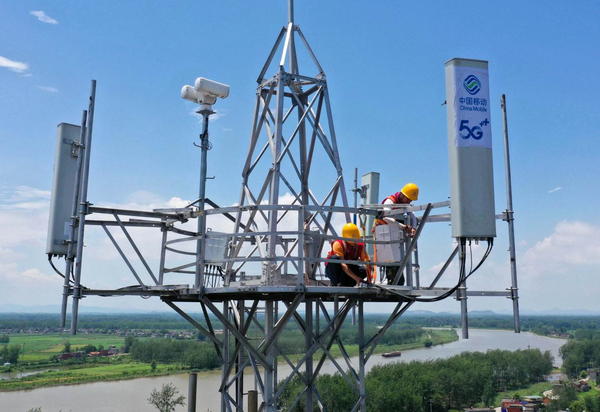By Han Xin, People’s Daily
As high-quality network system has become the foundation of the digital economy in the Internet era, especially the 5G era, China is making great efforts to foster integrated application of 5G networks and 1,000M fiber optic networks.
The coordinated development of the two types of networks in the entire process and all sectors of economic and social development will effectively boost industrial transformation and development.
Li Qin, a citizen of Chaoyang District, Beijing, is now able to download a high-definition movie in less than 20 seconds after she upgraded her broadband connection to a 1,000M Internet service.
What Li uses now is a 5G Internet service plan launched by China Mobile’s Beijing branch, which gives users access to a 1,000M Internet connection featuring high speed and low latency.

Network speed in China has significantly increased since the country announced for the first time in 2015 that it would lower prices for Internet services and elevate Internet connection speeds.
Data released by a third-party organization have indicated that China’s average broadband download speed increased nearly 14 times from 4.25Mbps at the end of 2014 to 62.5Mbps at the end of 2021.
Over the past seven years, the country has built the world’s largest and technologically advanced network facilities, with 1,000M fiber optic networks capable of serving 400 million families and 1.85 million 5G base stations installed nationwide.
In March 2021, China’s Ministry of Industry and Information Technology (MIIT) released an action plan on promoting the collaborative development of 5G networks and 1,000M fiber optic networks, and deploying the two types of networks in more than 100 Chinese cities by the end of 2023. Over the past year, the country has witnessed nationwide efforts to realize the goal.
“5G networks and 1,000M fiber optic networks can provide mobile and fixed networks to users with features such as ultra-large bandwidth, ultra-low latency, and advanced and reliable performance. The two types of networks are complementary to each other and together serve as the foundation of new infrastructure,” said an official with the MIIT.

The collaborative development of the two types of networks is a key measure to the overall plan of lowering prices for Internet services and elevating Internet connection speeds, noted the official. The development will not only help China maintain its leading position in the global telecommunications industry, but will continuously inject impetus into the digital transformation of the country’s manufacturing sector, noted the official.
During the past year, China has made new progress in improving the capacity of 5G networks and 1,000M fiber optic networks across the country. Data suggested that as of the end of May this year, every 10,000 people in China had enjoyed 12.1 5G base stations. Urban areas of all the prefecture-level cities, counties, and 92 percent of the central areas of townships had been covered by 5G networks. The number of families using 1,000M fiber optic networks surpassed 55 million.
So far, 29 cities in China, including Beijing, Shanghai, and Tianjin, have gained access to 5G networks and 1,000M fiber optic networks, according to an official with the MIIT.
While significantly improving the network capacity of urban areas, 5G networks and 1,000M fiber optic networks, together with a multitude of emerging technologies, have empowered many industries and innovative applications.
In recent years, in-depth integration of 5G networks and 1,000M fiber optic networks has brought about profound changes in industries including industrial manufacturing, logistics and ports, health, and education, with more than 20,000 application cases.

Thanks to the 5G network, voice recognition technology is playing a more important role in power inspection Workers in the main control room of the Ultra-high voltage converter station can accurately check the operation of facilities by logging in an AI inspection system developed by the Chinese AI firm iFlytek Co. Ltd.
“The combination of 5G networks, which are known for their low latency and high stability, and AI technologies, has made remote real-time data processing, feedback, and early warning possible,” said Zhang Chenchen, an executive of the State Grid Anhui Electric Power Co., Ltd.
During this year’s June 18 online shopping festival, more than 100 automated guided vehicle robots were put into service for sorting out parcels at a smart logistics park established by JD Logistics, Inc., the delivery arm of Chinese e-commerce giant JD.com, in Changsha, central China's Hunan Province.
The robots empowered by the 5G network demonstrated great work efficiency and handled up to 110,000 pieces of parcels per day.
China will continue to encourage relevant parties to enhance cooperation so as to further unleash the potential of networks and jointly make technological innovations for the integrated application of 5G networks and 1,000M fiber optic networks.
Aiming for increasing Internet speeds more prudently and lowering Internet service prices in a more targeted manner, China will strive to improve network coverage in urban areas, boost the application of 5G networks and 1,000M fiber optic networks, and make efforts to lower service prices, particularly for special groups and micro, small and medium-sized enterprises.


